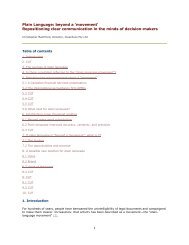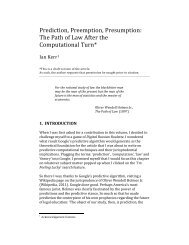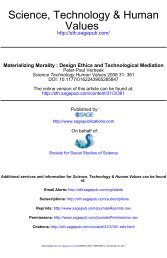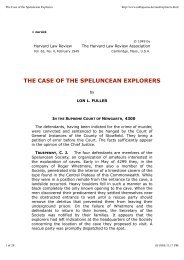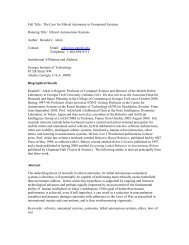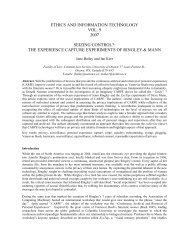'Asimov's Laws of Robotics' - the Laws of Robotics 2013
'Asimov's Laws of Robotics' - the Laws of Robotics 2013
'Asimov's Laws of Robotics' - the Laws of Robotics 2013
- No tags were found...
You also want an ePaper? Increase the reach of your titles
YUMPU automatically turns print PDFs into web optimized ePapers that Google loves.
Roger Clarke's <strong>'Asimov's</strong> <strong>Laws</strong> <strong>of</strong> <strong><strong>Robotics</strong>'</strong><strong>2013</strong>-09-03 10:33 AMMy purpose here is to determine whe<strong>the</strong>r or not Asimov's fiction vindicates <strong>the</strong> laws he expounded. Does hesuccessfully demonstrate that robotic technology can be applied in a responsible manner to potentiallypowerful, semi-autonomous and, in some sense intelligent machines? To reach a conclusion, we mustexamine many issues emerging from Asimov's fiction.HistoryThe robot notion derives from two strands <strong>of</strong> thought, humanoids and automata. The notion <strong>of</strong> a humanoid(or human- like nonhuman) dates back to Pandora in The Iliad, 2,500 years ago and even fur<strong>the</strong>r. Egyptian,Babylonian, and ultimately Sumerian legends fully 5,000 years old reflect <strong>the</strong> widespread image <strong>of</strong> <strong>the</strong>creation, with god- men breathing life into clay models. One variation on <strong>the</strong> <strong>the</strong>me is <strong>the</strong> idea <strong>of</strong> <strong>the</strong> golem,associated with <strong>the</strong> Prague ghetto <strong>of</strong> <strong>the</strong> sixteenth century. This clay model, when brea<strong>the</strong>d into life, became auseful but destructive ally.The golem was an important precursor to Mary Shelley's Frankenstein: The Modern Prome<strong>the</strong>us (1818). Thisstory combined <strong>the</strong> notion <strong>of</strong> <strong>the</strong> humanoid with <strong>the</strong> dangers <strong>of</strong> science (as suggested by <strong>the</strong> myth <strong>of</strong>Prome<strong>the</strong>us, who stole fire from <strong>the</strong> gods to give it to mortals). In addition to establishing a literary traditionand <strong>the</strong> genre <strong>of</strong> horror stories, Frankenstein also imbued humanoids with an aura <strong>of</strong> ill fate.Automata, <strong>the</strong> second strand <strong>of</strong> thought, are literally "self- moving things" and have long interested mankind.Early models depended on levers and wheels, or on hydraulics. Clockwork technology enabled significantadvances after <strong>the</strong> thirteenth century, and later steam and electro- mechanics were also applied. The primarypurpose <strong>of</strong> automata was entertainment ra<strong>the</strong>r than employment as useful artifacts. Although many patternswere used, <strong>the</strong> human form always excited <strong>the</strong> greatest fascination. During <strong>the</strong> twentieth century, several newtechnologies moved automata into <strong>the</strong> utilitarian realm. Geduld and Gottesman 8 and Frude 2 review <strong>the</strong>chronology <strong>of</strong> clay model, water clock, golem, homunculus, android, and cyborg that culminated in <strong>the</strong>contemporary concept <strong>of</strong> <strong>the</strong> robot.The term robot derives from <strong>the</strong> Czech word robota, meaning forced work or compulsory service, orrobotnik, meaning serf. It was first used by <strong>the</strong> Czech playwright Karel Çapek in 1918 in a short story andagain in his 1921 play R. U. R., which stood for Rossum's Universal Robots. Rossum, a fictional Englishman,used biological methods to invent and mass- produce "men" to serve humans. Eventually <strong>the</strong>y rebelled,became <strong>the</strong> dominant race, and wiped out humanity. The play was soon well known in English- speakingcountries.DefinitionUndeterred by its somewhat chilling origins (or perhaps ignorant <strong>of</strong> <strong>the</strong>m), technologists <strong>of</strong> <strong>the</strong> 1950sappropriated <strong>the</strong> term robot to refer to machines controlled by programs. A robot is "a reprogrammablemultifunctional device designed to manipulate and/or transport material through variable programmedmotions for <strong>the</strong> performance <strong>of</strong> a variety <strong>of</strong> tasks"9. The term robotics, which Asimov claims he coined in1942 10 refers to "a science or art involving both artificial intelligence (to reason) and mechanical engineering(to perform physical acts suggested by reason)"11.As currently defined, robots exhibit three key elements:http://www.rogerclarke.com/SOS/Asimov.htmlPage 4 <strong>of</strong> 30



